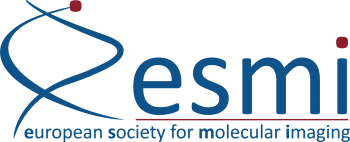Accurate detection of tumor tissue is a key feature in the diagnosis of cancer, and surgery is one of the major pillars in further management of the disease. The inability of complete excision of cancerous tissue during a surgical procedure can increase the need for reexcision or excessive postoperative radio- and/or chemotherapy. Interventional molecular imaging creates the opportunity to integrate pre- and intraoperative imaging procedures, resulting in more accurate surgical visualization of the areas of interest and improved surgical outcome.
The sentinel lymph node (SLN) biopsy is an ideal procedure for the initial evaluation of the potential of combined pre- and intraoperative imaging approaches. Currently radiocolloids such as 99mTc-nanocolloid are the clinical standard for preoperative SLN mapping. Unfortunately, intraoperatively, the radioactive signal has to be acoustically traced for SLN localization. Visual guidance is obtained after additional injection of dyes, e.g. patent blue, which does not always increase efficiency. By using hybrid nanoparticle-based imaging agents, containing both a radio- and fluorescent label, preoperative findings can be intraoperatively detected using an optical device. A good example of a hybrid particle that induces sufficient retention in the lymph node is ICG-99mTc-nanocolloid, which is formed after complex formation between the clinically approved radiolabeled albumin-colloid (nanocolloid) and near-infrared fluorescent dye indocyanine-green (ICG).
Preclinical studies in mouse models for metastatic breast and prostate cancer revealed that while free ICG was rapidly cleared, the drainage and retention pattern of ICG- 99mTc-nanocolloid was highly similar to that of 99mTc-nanocolloid. The hybrid nature of ICG- 99mTc-nanocolloid also enabled intraoperative SLN identification via near-infrared fluorescence imaging. In vivo stability of the complex was underlined by the high correlation between the radioactive and fluorescence signal intensities.
Clinically, the added value of combined pre- and intraoperative imaging using ICG- 99mTc-nanocolloid was studied in patients with melanoma in the head and neck region or the trunk, with penile carcinoma or with prostate carcinoma. These studies comprised both open and laparoscopic surgical procedures. The lymphoscintigraphic drainage patterns of 99mTc-nanocolloid and ICG-99mTc-nanocolloid were identical, and the preclinically observed in vivo complex stability could be confirmed. Furthermore, radioguidance and intraoperative fluorescence imaging were found to be complementary. Fluorescence particularly improved surgical guidance in areas with a high radioactive background signal such as at the injection site, whereas radioguidance was found to overcome the limited tissue penetration of the fluorescence signal. The fluorescent component of ICG-99mTc-nanocolloid also facilitated the evaluation of the placement of tracer injection in patients with prostate cancer.
Unfortunately ICG-99mTc-nanocolloid does not enable the specific detection of tumor cells. For tumor specific visualization, imaging agents that target a specific biomarker on a tumor cell are required. The chemokine receptor 4 (CXCR4) is a membranous biomarker that is overexpressed in many types of cancer and has recently emerged as a target in the field of molecular imaging and therapeutics. For targeting of CXCR4 the antagonistic peptide T140 and its derivatives can be used.
Functionalization of the T140 derivative Ac-TZ14011 with the fluorescent dye fluorescein isothiocyanate (FITC) enabled discrimination between cells with a clinically relevant 4-fold difference in CXCR4 expression, while the efficacy was comparable to commercially available anti-CXCR4-antibodies.111In-DTPA-Ac-TZ14011 was able to detect CXCR4 receptor expression in MIN-O mouse tumor lesions, resembling human ductal carcinoma in situ. Longitudinal monitoring enabled discrimination between preinvasive early stage, intermediate, and invasive late stage MIN-O tumor lesions as CXCR4 expression increased during lesion progression. Addition of a multifunctional single attachment point reagent (MSAP) containing both a diethylenetriaminepentaacetic acid (DTPA) chelate and a fluorescent dye, was shown to have a similar influence on the CXCR4 receptor affinity as the FITC and DTPA label and enabled integration of the pre- and intraoperative setting. Multimerization could be used to reduce the nonspecific binding, resulting in a higher tumorto-muscle ratio.
Uniquely, MSAP-Ac-TZ14011 enabled extension of the hybrid approach by integrating biopsy based biomarker screening, in vivo imaging and ex vivo target validation of tumor tissue using a single agent. Flow cytometric analysis revealed different CXCR4 positive populations in MIN-O tumor specimens, which could be used to accurately stage the lesion progression. Results from this initial screening were found to be predictive for the feasibility of in vivo tumor visualization as well as ex vivo evaluation of the excised tissue.
In conclusion, the results described in this thesis show the great potential of hybrid imaging agents in the translation of preoperative molecular imaging findings to an interventional setting. The hybrid concept was proven to be beneficial during clinical SLN biopsy procedures. This concept was effectively translated to the visualization of tumor cells in a preclinical setting using CXCR4 as an example. Ongoing investigations using intraoperative navigation and preoperative delineation of lesions will provide an even wider platform for the described hybrid approach, hereby continuing to improve the accuracy of surgical guidance.
Congratulations!
“I will continue to work in the field of molecular imaging as a postdoctoral fellow within the Interventional Molecular Imaging group of Dr. Fijs van Leeuwen. While consolidating on the knowledge and contacts obtained during my time as a PhD student, I am now broadening my scope and focus on intraoperative imaging approaches for peripheral nerves. These studies are being performed in close collaboration with Prof. Martijn Mallessy who is a well renowned dedicated nerve surgeon. As a visiting scientist at the Netherlands Cancer Institute, I will, however, remain involved in the use of (advanced) tumor models for molecular imaging studies (collaboration with Dr. Jos Jonkers).
Tessa Buckle on her future carreer plans
Based on these combined efforts I will try to keep developing scientifically and build on a career as an independent scientist in the field of molecular imaging /surgical guidance.”
